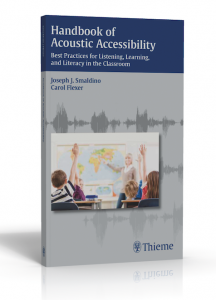Book Review
Handbook of Acoustic Accessibility: Best practices for listening, learning, and literacy in the classroom. (2012) edited by Joseph Smaldino and Carol Flexer. Thieme Publishing: New York, ISBN# 978-1-60406-765-1.
 As the editor of Canadian Audiologist I receive many books that I redirect to my audiology colleagues for a book review. From time to time I find a gem and I decide to hang onto the book since I would like it for my own bookshelf – in cases like this I get to do the book review myself. Although I just received this book in my in-box it was published in 2012. Nevertheless the text is still quite current and touches on a wide selection of topics. Many of the references are quite dated but this in itself is not a drawback – these references are some of the classic works that have defined this area.
As the editor of Canadian Audiologist I receive many books that I redirect to my audiology colleagues for a book review. From time to time I find a gem and I decide to hang onto the book since I would like it for my own bookshelf – in cases like this I get to do the book review myself. Although I just received this book in my in-box it was published in 2012. Nevertheless the text is still quite current and touches on a wide selection of topics. Many of the references are quite dated but this in itself is not a drawback – these references are some of the classic works that have defined this area.
When you open the book you immediately see some of the most influential people in our field and include names like Arthur Boothroyd and Mark Ross – both pioneers. The 9 chapter book is almost set up like a book on hearing aids – it starts with a chapter on measurement, then talks about available systems to improve the signal to noise ratio, verification of the acoustic design, and a chapter on best practices. I don’t think that this was an accident. That comprehensive approach is as important for establishing and maintaining acoustic accessibility as it is in prescribing and verifying an optimal hearing aid fitting.
Chapter 1, by Dr. Mark Ross, provides an historical perspective to the topic of acoustic access. Dr. Ross provides a review of his personal encounters with auditory access over his lifetime starting with the maternal rubella outbreak in the mid-1960s. Classrooms were just not ready for what was about to happen – an onslaught of deaf and students with hearing loss being mainstreamed into noisy classrooms with a very poor signal to noise ratio. This is followed by a nice chapter by Dr. Arthur Boothroyd on speech perception in the classroom, and chapters on devices, verification, and best practices as outlined by the American Academy of Audiology’s Best Practice Guidelines for Hearing Assistance Technology.
This is not a long book – less than 150 pages – but what is covered is to the point and clinically relevant. This book does not belong on your bookshelf – it should be sitting on your desk right next to a copy of your favourite hearing aid or evoked response text.

